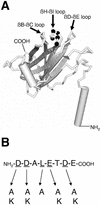A conserved capsid protein surface domain of Cucumber mosaic virus is essential for efficient aphid vector transmission
- PMID: 12208954
- PMCID: PMC136502
- DOI: 10.1128/jvi.76.19.9756-9762.2002
A conserved capsid protein surface domain of Cucumber mosaic virus is essential for efficient aphid vector transmission
Abstract
A prominent feature on the surfaces of virions of Cucumber mosaic virus (CMV) is a negatively charged loop structure (the beta H-beta I loop). Six of 8 amino acids in this capsid protein loop are highly conserved among strains of CMV and other cucumoviruses. Five of these amino acids were individually changed to alanine or lysine (an amino acid of opposite charge) to create nine mutants (the D191A, D191K, D192A, D192K, L194A, E195A, E195K, D197A, and D197K mutants). Transcripts of cDNA clones were infectious when they were mechanically inoculated onto tobacco, giving rise to symptoms of a mottle-mosaic typical of the wild-type virus (the D191A, D191K, D192A, E195A, E195K, and D197A mutants), a systemic necrosis (the D192K mutant), or an atypical chlorosis with necrotic flecking (the L194A mutant). The mutants formed virions and accumulated to wild-type levels, but eight of the nine mutants were defective in aphid vector transmission. The aspartate-to-lysine mutation at position 197 interfered with infection; the only recovered progeny (the D197K(*) mutant) harbored a second-site mutation (denoted by the asterisk) of alanine to glutamate at position 193, a proximal site in the beta H-beta I loop. Since the disruption of charged amino acid residues in the beta H-beta I loop reduces or eliminates vector transmissibility without grossly affecting infectivity or virion formation, we hypothesize that this sequence or structure has been conserved to facilitate aphid vector transmission.
Figures


References
-
- Atreya, P. L., J. J. Lopezmoya, M. H. Chu, C. D. Atreya, and T. P. Pirone. 1995. Mutational analysis of the coat protein N-terminal amino acids involved in potyvirus transmission by aphids. J. Gen. Virol. 76:265-270. - PubMed
-
- Callaway, A., D. Giesman-Cookmeyer, E. T. Gillock, T. L. Sit, and S. A. Lommel. 2001. The multifunctional capsid proteins of plant RNA viruses. Annu. Rev. Phytopathol. 39:419-460. - PubMed
-
- Chen, B., and R. I. B. Francki. 1990. Cucumovirus transmission by the aphid Myzus persicae is determined solely by the viral coat protein. J. Gen. Virol. 71:939-944.
Publication types
MeSH terms
LinkOut - more resources
Full Text Sources

